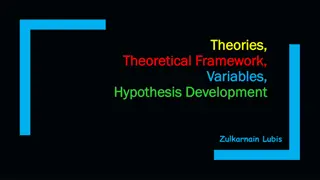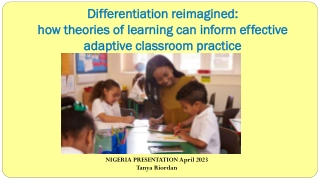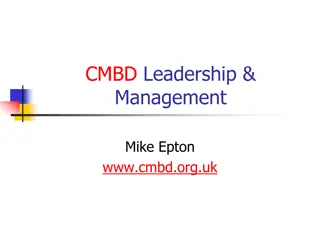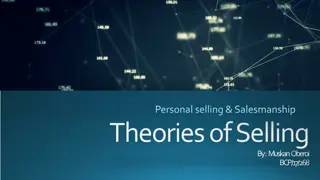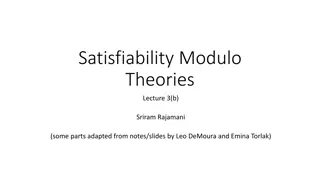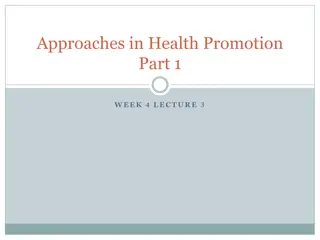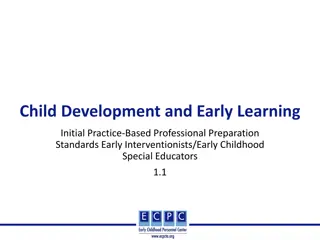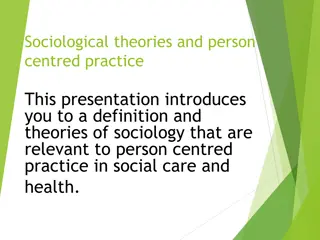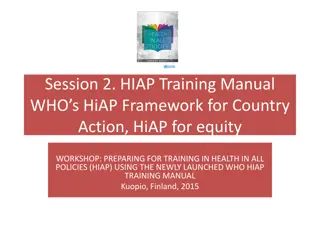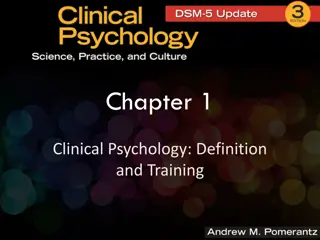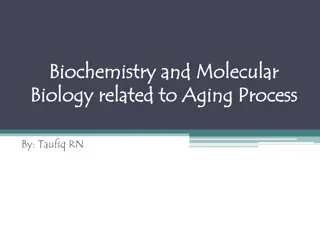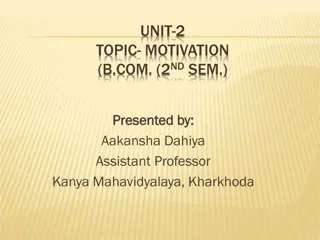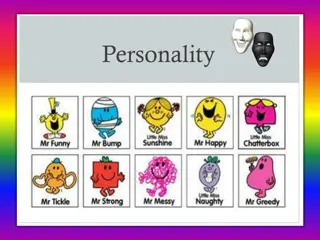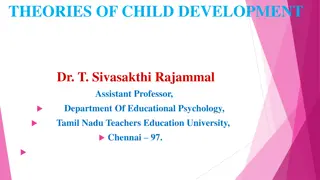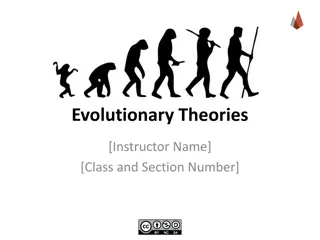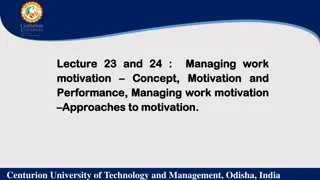Integrating Theories and Models for Enhanced Health Practice
Explore the application of theories, perspectives, and practice models in integrated health through Module 3. Learn how theories guide assessment, treatment, and patient outcomes. Discover common theories enhancing assessment and supporting individuals through grief and loss. Gain insights into the value of theories in clinical practice.
Download Presentation

Please find below an Image/Link to download the presentation.
The content on the website is provided AS IS for your information and personal use only. It may not be sold, licensed, or shared on other websites without obtaining consent from the author. Download presentation by click this link. If you encounter any issues during the download, it is possible that the publisher has removed the file from their server.
E N D
Presentation Transcript
Applying Theories, Perspectives, and Practice Models to Integrated Health Module 3 Judith Anne DeBonis PhD Department of Social Work California State University Northridge
Module 3 Theories, Perspectives, and Practice Models in Integrated Health By the end of this module students will: Learn how a variety of theories, perspectives and practice models can be useful in their application to Integrated Health Identify and understand the impact of personal (practitioner and patient) practice and explanatory models on clinical practice and behavior Gain experience, skill, and confidence (through practice scenarios) in applying theories to practice Increase more detailed knowledge and understanding of the application of Stage of Change theory to Integrated Health
The Basic Value of Theories 1 Theories help us to explain or predict behavior, to inform policy, guide practice and direct research. For behavioral health professionals: Inform the questions we ask Frame the comprehensiveness of our assessment It is the theory that decides what we can observe. Albert Einstein Offer a vantage point that respects diversity and complexity Provide a lens through which we organize vast amount of information or view data
Contribution of Theory to Integrated Health? 2 Assessment is part of treatment When conducted effectively, a good assessment is not just about diagnosis, but offers opportunities for the patient to identify strengths and gain insight and self-understanding. Theories can act as a roadmap for the questions to ask or for decisions about the direction taken in an assessment. It can offer options for strengthening the partnership with the patient and encourage practitioner s to consider a variety of vantage points which can lead to a more comprehensive understanding of the patient s experiences
Using Common Theories to Enhance Assessment 3 Behavior is influenced by a person s environment. Interventions aimed at the individual and the environment have potential for positive outcomes. Environmental or Systems Theory Human Developmental Theory People have different needs and capacities related to the current phase of their life history. All persons experience losses that have the potential to result in feelings and reactions: denial, anger, depression, bargaining, and acceptance. No one should try to go it alone. Having access to a network of support may result in improved healthcare outcomes. Grief and Loss Theory Social Support Theory
Group Activity Generating Questions Associated with Theories Think of your client population. What areas of a person s life come to mind when you consider how these theories relate to that person? Environmental or Systems Theory Human Developmental Theory Applying the theory to your practice Grief and Loss Theory Brainstorm at least 2 questions for each theory that lead you to a better understanding of the person. Social Support Theory
Biological, Psychological, Social Relational and Spiritual Aspects A Person-Focused Approach1 Purpose Contributions Collects information regarding history, development, biology, genetics, psychology, social, spiritual, and environmental aspects of health Offers a structure to examine current mental status Provides insight into personal strengths and weakness including social role, environmental resources, mental health and physical health Holistic- person and situation context Helps tie together theories to better understand aspects of the person and environment Gives integration and interconnectedness to contrasting qualities of the person Identifying possibilities for engaging micro and macro systems of practice
Group Activity Person and Environmental Focused Mandalas We do not give priority to either the person or the environment, but rather see person and environment as inextricably related. 1 1. Using the mandalas (on the next slide) of human behavior theories, consider how these various theories might be useful in practice with people who have a combination of health, mental health, and substance use disorders. Start by examining a clinical case example, or reading a narrative written by a person living with one or more of chronic conditions. Applying both the person-focused and environmental mandalas, examine how they interact and impact on the person s experience. 2. 3.
Person and Environmental Focused Mandalas1 Environmental-Focused Person-Focused
Explanatory Models Take a few minutes to think about and discuss the following question: What is your explanatory model for mental health and substance use problems? Stories and experiences from real life Messages we carry with us Impact on our role as a social worker
Stress Vulnerability
History of Mental Disorders Ancient Egyptians did not differentiate between mental and physical illnesses4 Thought the heart was responsible for mental symptoms Later shifted to blaming, stigmatizing5 The label of mental illness became the entire definition of who the person is Stigma continues to be one of the largest barriers to understanding and treatment
Typical Reactions Towards Mental Illness6 Myths and misconceptions about mental illness: Depressed people should just snap out of it The mentally ill are dangerous, often commit crimes All mental illness involves psychotic episodes It s fun to be manic Schizophrenia = multiple personality disorder Families are the cause of mental illness Supportive therapy can t help the mentally ill People with schizophrenia can only do low level jobs A schizophrenic is a schizophrenic is a schizophrenic Despite new scientific evidence and information, these ideas persist
Factors Contributing to Mental Health Disorders6 A combination of environmental and genetic factors contribute to mental illness No blood test for mental illness Common for individuals to blame themselves for their feelings, thoughts, and behaviors Common to feel embarrassed about them Mental disorders are not caused by personal laziness or weak character
The Stress Vulnerability Model7 Amount of vulnerability differs from person to person For some conditions, related to factors like early exposure to viral infection in utero Impacts vulnerability by either triggering the onset of the disorder or worsening the course Stress can include life events, relationships, etc. Illness/ symptoms Genetics, biological vulnerabilities Stress in the environment Combinations of stress and vulnerabilities may lead to different types of a disorder Individuals and families can build protective factors to minimize or manage stress May help reduce severity of symptoms and impact the illness course positively Reduce person s biological vulnerability and stress Factors include medication, coping skills, communication, and problem solving skills and structure Protective factors
Group Activity How do the causal models of mental health disorders impact practice? What are some of the benefits that come from understanding the causal factors for mental health and substance use disorders? Does increased understanding help to reduce the associated stigma? What impact can knowledge about causal factors have on the person and the family? How would you apply the knowledge from the stress vulnerability model to help people reduce the severity of their symptoms and positively impact their illness course?
Practice Theory Models Take a few minutes to think about and discuss the following question: What are the essential components of your practice model for mental health and substance use problems? What is your belief about change? What motivates persons to take action on behalf of their health? How hopeful are you that recovery is possible? Can persons with chronic conditions also be resilient?
Practice Theory Models8 Assumptions of three dimensions: Human Behavior Change Process Interventions Assumptions and research about risk and resilience factors that affect human development and behavior Theories about how people change their thoughts, feelings, and behaviors in different situations Skills Techniques Strategies Used in the practitioner- client interactions Why do people behave as they do? What role does the environment play? How do people change? What activates or motivates the process? What activities can improve client adaptation or well-being?
Critical Examination of Theory8 While practice theories have made positive contributions to social work practice, they all have strengths and limitations Scientific evidence does not support the theoretical assumptions 1 While there may be merit in the underlying theory, the intervention has not been adequately tested or shown to be effective 2 The theory is not broadly applicable to treating a wide range of psychosocial problems 3
Consider An Example9 The individual is a college student in their junior year at the local university where classes began a little more than a week ago. Read the process recording and note your thoughts as you take in the information being presented Please note specific information that appears most important or significant to your beginning understanding While you may want more information, think of what immediately comes to mind in terms of defining the problem or diagnosis and how you would go about starting to work with this person? As a group, take time to collect and process findings...
Process Recording9 I called last week to make this appointment because I just felt that I was not going to make it. I felt so anxious and stressed at school the other day, I had to leave and did not attend my first class session. Actually, it was my first day back in school since taking a break last year. I had pushed myself too hard with work, school, and trying to keep the gay alliance going, I just couldn t do it anymore. My drinking was getting worse and I was yelling at my partner so much I was always leaving to get away to clam down. My Dad would hit my Mother and he drank a lot. Maybe I am just too much like him .
Basic Assumptions of Strengths Perspective10,11,12 Everyone possesses strengths Motivation is increased when strengths are emphasized Cooperative, mutually respectful relationships promote identification of client strengths Focusing on strengths diminishes the temptation to blame or judge All environments even the most bleak contain resources How many observations about the previous case example were strength-based? What percentage of the discussion focused on problems or took a deficit perspective?
Strengths-Based Practice? 9 Traditional models assume that truth is discovered only by looking at underlying and often hidden meanings that only professional expertise can understand? Medical/pathology vs. strengths/solution focus Shift in frames are not easy tasks Using the language of strengths is insufficient Frames provide a set of rules and expectations for behavior
Consider Some Examples13 Examples of not seeing what is there and examples of seeing what is not there My patients don t want to be empowered they want me to tell them what to do I want to empower my patients to improve their compliance with their treatment Some patients cannot be empowered due to age, education or culture I only use empowerment with some of my patients it s in my bag of tricks but I wouldn t use it with a newly diagnosed patient
Empowering Approach?13 Empowerment occurs when the practitioner s goal is to increase the capacity of the client to think critically and make autonomous, informed decisions it also occurs when clients are actually making autonomous informed decisions Reflect on your reactions Compliance vs. Adherence vs. Empowerment Challenge consider how fully the spirit of empowerment can be applied in clinical settings with various patient populations Empowerment is a process and an outcome No empowerment without respect
Defining Empowerment for Health Empowermentis a process by which people gain mastery over their lives. 14 J. Rappaport Empowerment is an educational process designed to help patients develop the knowledge, skills, attitudes, and degree of self-awareness necessary to effectively assume responsibility for their health-related decisions. 15 Feste Anderson
Sharing of Power16 Compliance Empowerment Let s decide together what is the best care for your conditions. You must do what I tell you. An authoritative act designed to reduce patient autonomy and constrain freedom of choice An agreement designed to support the promotion of self-management, taking into account the patients perspectives on their condition, their goals, expectations, and needs
Empowerment Applied17 Empowered Patients Own Their Health Condition Make decisions and direct their life in a way that helps them meet their goals Have skills for making decisions and changes as needed Active participants in: Setting goals Building action plans Identifying barriers Problem solving Are effective self-managers Comfortable and confident about taking needed action Have strong self-efficacy
How Do Patients Become Empowered?17,18 Through Self-Management Education Traditional Patient Education Self-Management Education Offers information Teaches problem solving Defines problems Helps patients identify problems, make decisions, take actions Self-management compliments rather than substitutes for traditional patient education A partnership will require both educators and learners to interact with respect as equals
Paolo Freire19 There isn t Dialogue Without Humility The content of education based on true dialogue is not intended to convey information or impose ideas It is to provide an organized structure so individuals can Identify their own goals Initiate their own decisions and actions Experience their own power Switching from a banking to a problem posing approach to education Education for liberation
Blooms Educational Model About Into, Through, and Beyond 20 Provide education and information on the basics Involve patients Into Knowledge 1 Offer patients opportunities to put information or skills into action Help patients to learn through experience Through Skill Building 2 Help patients go beyond the basics and fine-tune their skills Encourage patients to keep building on what they ve learned Beyond Increasing self efficacy 3
Group Activity Patient Education and Empowerment Using Bloom s 3-step model of education (from the previous slide) and Freire s model of empowerment, practice through role play how you might assess a patient s educational needs and individualize the needs based on the three different steps. Based on these models, how might you modify or enhance any current patient educational materials that you ve seen used in our healthcare system? Consider the advantages, disadvantages and impact of an individualized model vs. the one size fits all educational approach?
The Real Goal of Empowerment is Increased Self Efficacy 21 Patient Empowerment Increased Sense of Self-Efficacy Increased self-efficacy allows patients to view disease and symptoms differently, giving more opportunities for effective self-management 21 Enhanced Self- Management Skills
Patient as Central to the Process16 Individuals Makes Decisions About: Life-style The person is, in fact, the true manager of his or her well being. Ultimately, the question is not whether patients will manage their health or diseases, but how they will manage. Taking medicine Physical activity Blending information with personal culture, expectations, wishes, and attitude
Medical Model1 vs. Person-Centered Model of Care1 Traditional Medical Model Evolving Healthcare Model Person-Centered Model
Important Changes in Health Management22 Three points: Chronic disease is the major reason for seeking healthcare in the U.S. Treating chronic medical conditions requires a different model of care The new models of care for chronic conditions require a change in both patient and provider roles The Global Burden of Disease, a study sponsored by the World Health Organization, projected that by the year 2020, mortality and disability from disease would shift from predominantly acute illnesses to chronic conditions.
1) Chronic Disease: The Major Reason for Seeking Healthcare in the U.S.22 Shift from acute illnesses to chronic conditions Chronic disease is the primary cause of disability in the U.S. Chronic disease accounts for 70% of all healthcare expenditures in the U.S. As many as 45% of the general population and 88% of persons aged 65 or older have at least one chronic condition
2) Treating Chronic Conditions Requires a Different Model of Care23
3) Need for Change in Patient and Provider Roles24,25 The patient/professional partnership involves collaborative care and self-management education Patients are expected to do what is needed on a daily basis Providers act as consultants, resource persons, and offer treatment suggestions Patient/Healthcare Provider Team Healthcare Providers Provide clinical expertise, experience with the chronic condition, and evidence-based knowledge Patients Know more about themselves, what motivate them, what they are willing to change, and what has helped them feel better
Wagners Chronic Care Model26 Improved Health Outcomes are achieved when patients take an active role in their care. Social Work providers can serve to promote patient empowerment and behavioral activation which are essential to effective self-management.
Lorigs Components of Self-Management 23,24,27 Living with a chronic condition requires patient self-management in three key areas: Medical Management Behavioral Management Emotional Management Take medicines, adhere to special diet, test blood sugars Adjust to life with chronic illness maintain, change, or create new life roles Deal with emotional consequences of having a chronic condition
Group Activity Good Chronic Care Requires Self-Management Growing evidence from around the world suggests that patients with chronic conditions do better when they receive effective treatment within an integrated system of care which includes self-management support and regular follow up. 22 Consider the Following Questions: How would you create effective treatment that includes self-management support and regular follow-up? What characterizes a prepared practice team? What characterizes an informed practice team? What characterizes an informed activated patient?26 What specifically can social work providers do to promote patient empowerment toward behavioral activation?
Health Belief Model 3,28 Purpose Contribution Offers understanding or insight into a person: How the person prioritizes health and health problems Belief about the causes health problems or what symptoms mean Hopefulness about whether treatment will help Sense of how worthwhile certain actions might be in preventing disease or treating health problems or risks Helps individualize a comprehensive assessment: What do you think caused your problems? Why do you think it started when it did? How does it effect you? What worries you most? What kind of treatment do you think you should receive?
Group Activity Beliefs about Pain The messages that pain equals harm and or that all pain is a signal that something is wrong can contribute to disability and distress for persons with chronic conditions.28 Consider the Following Questions: Brainstorm about some of the common beliefs about pain and how these might impact behavior. What types of questions might you ask to understand the person s belief? How have they coped with pain? How could education and information be used to address these issues? What would the goal be?










